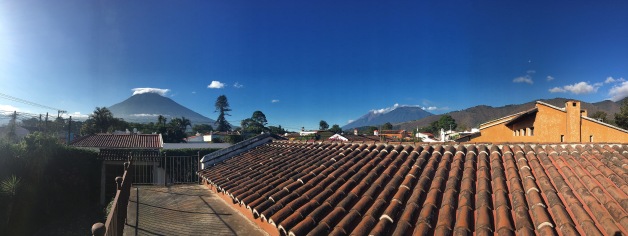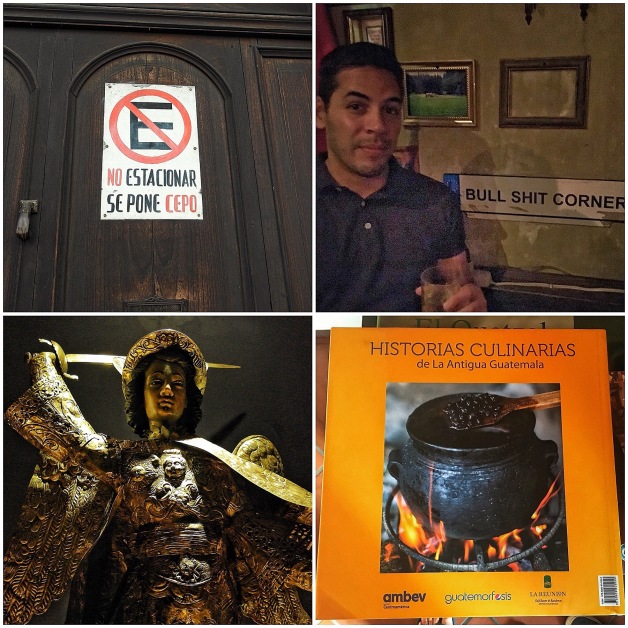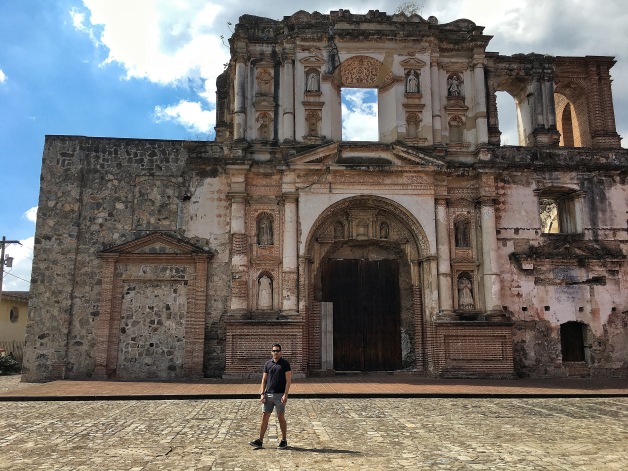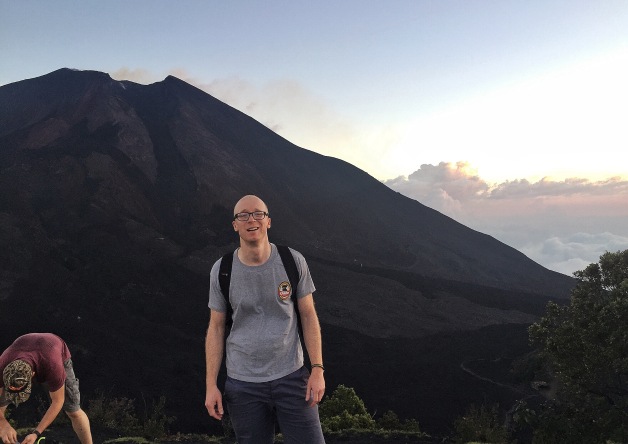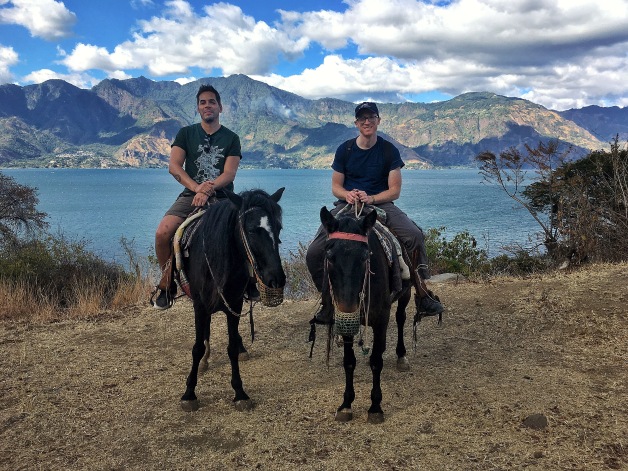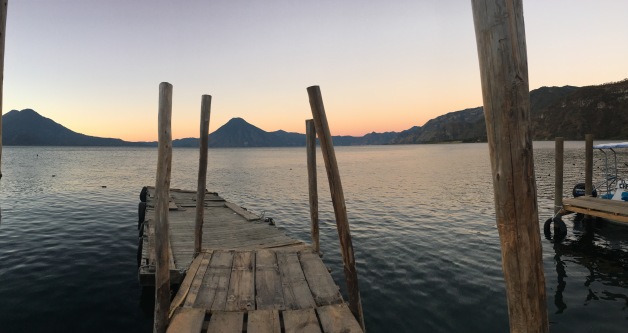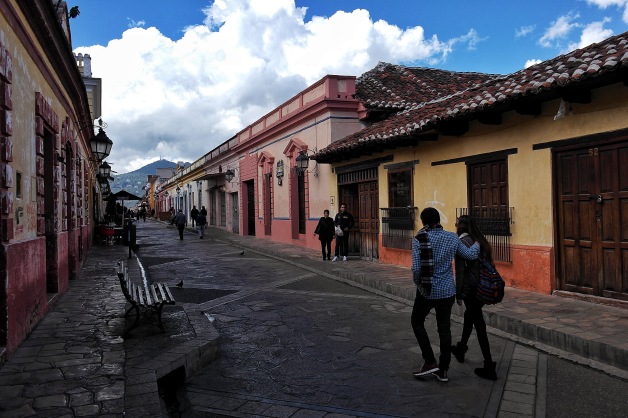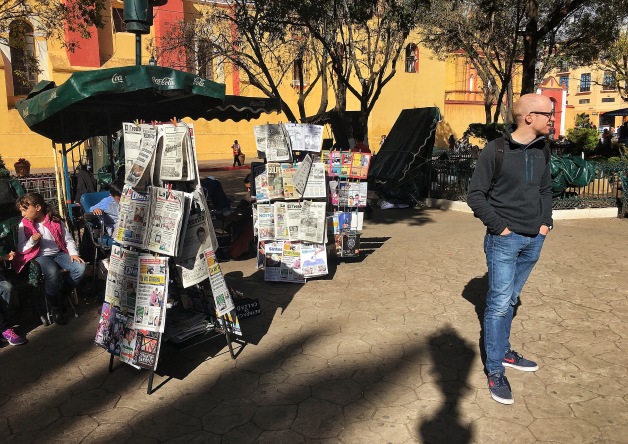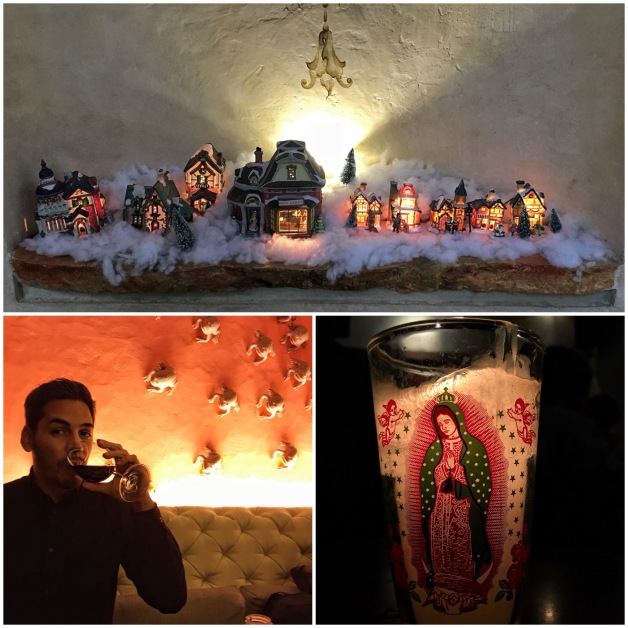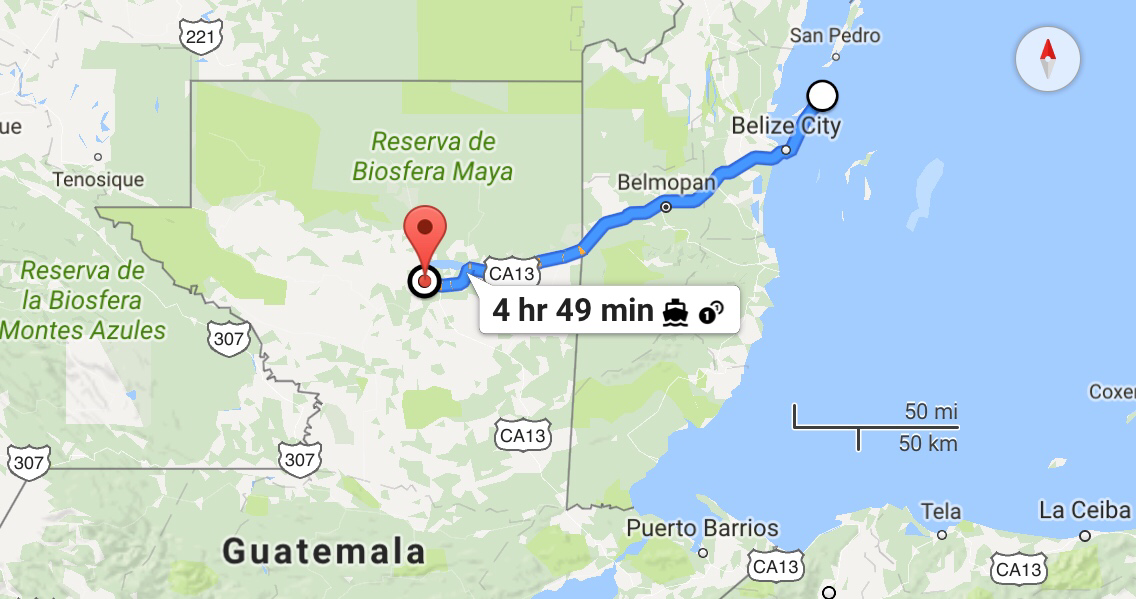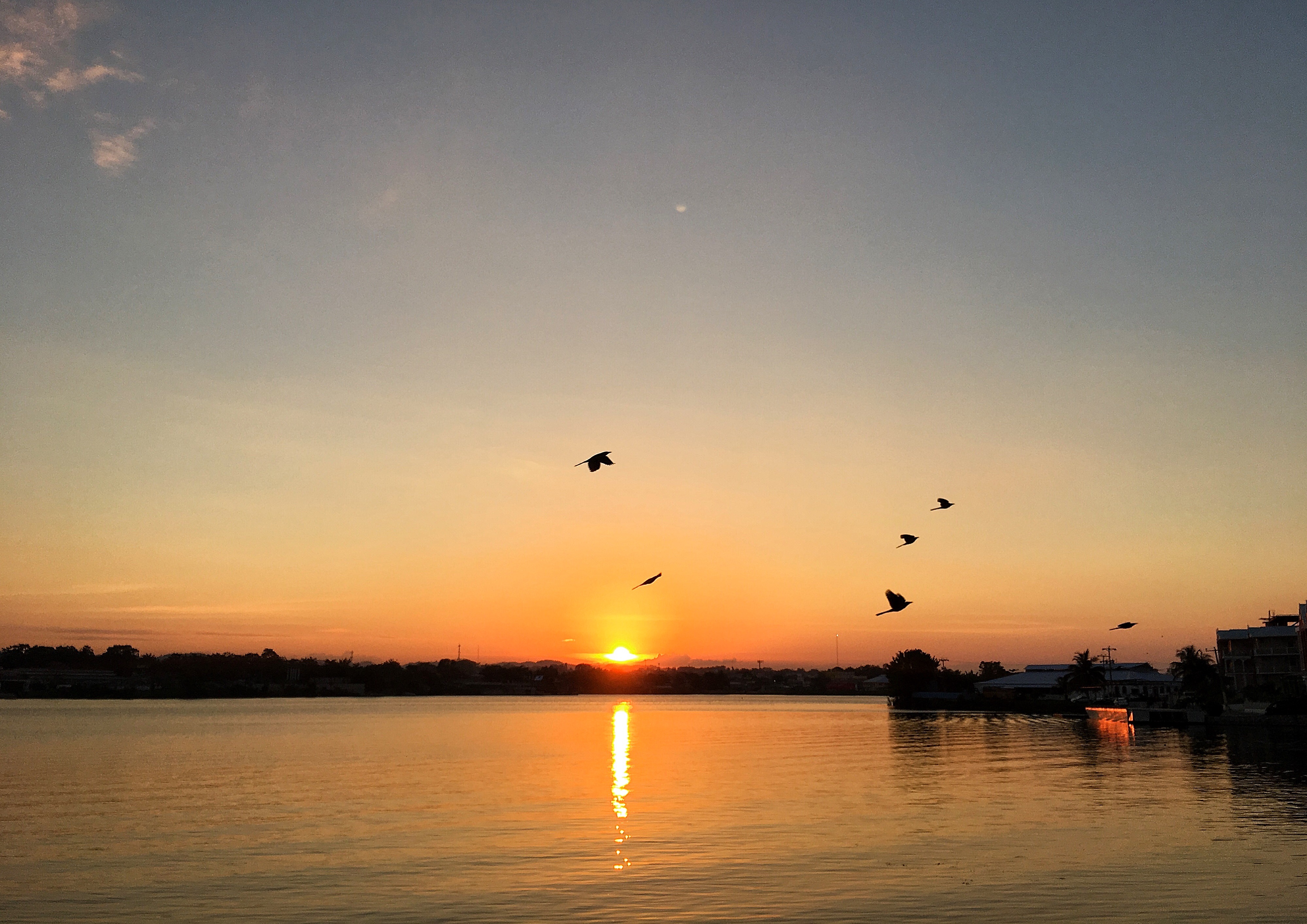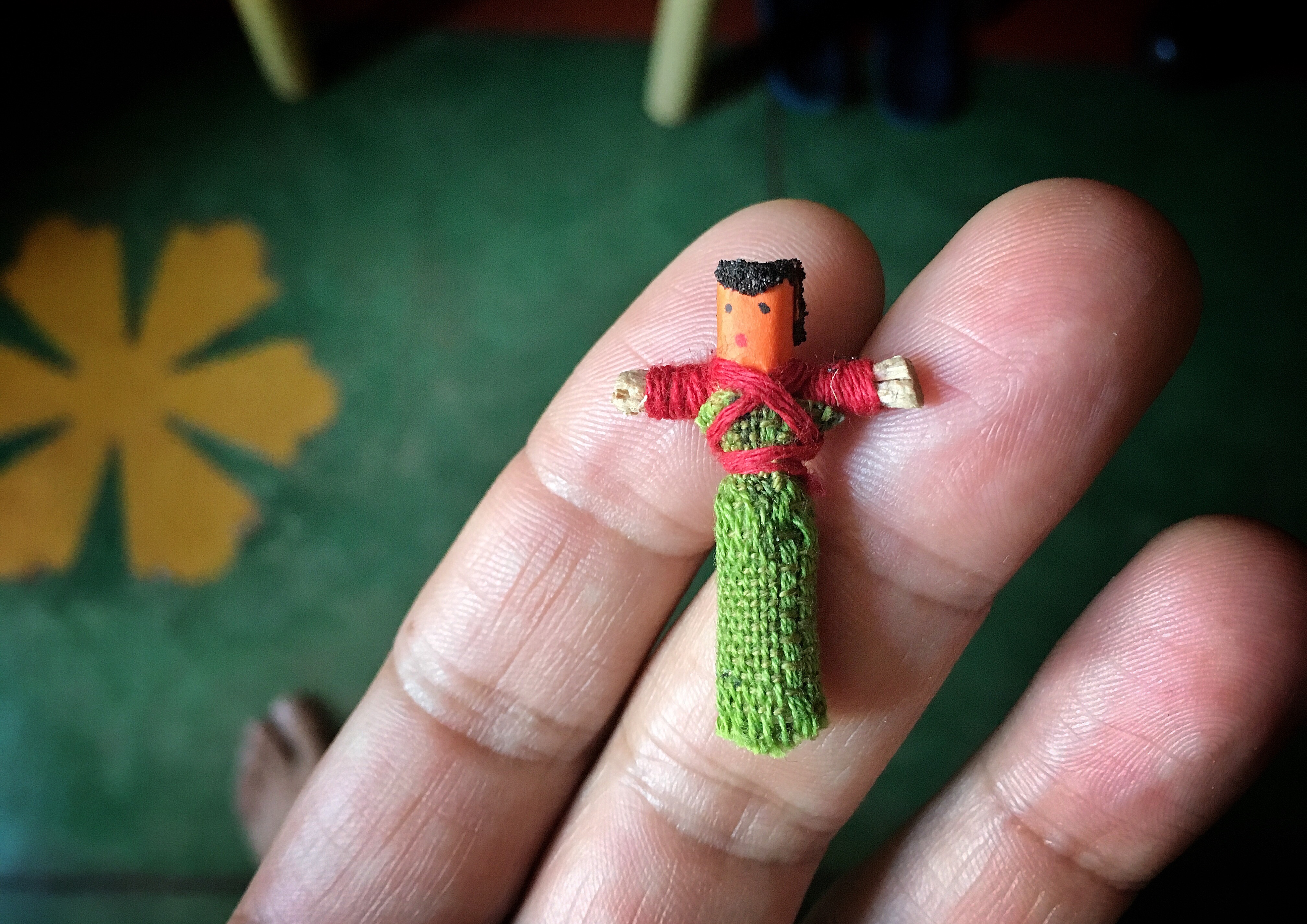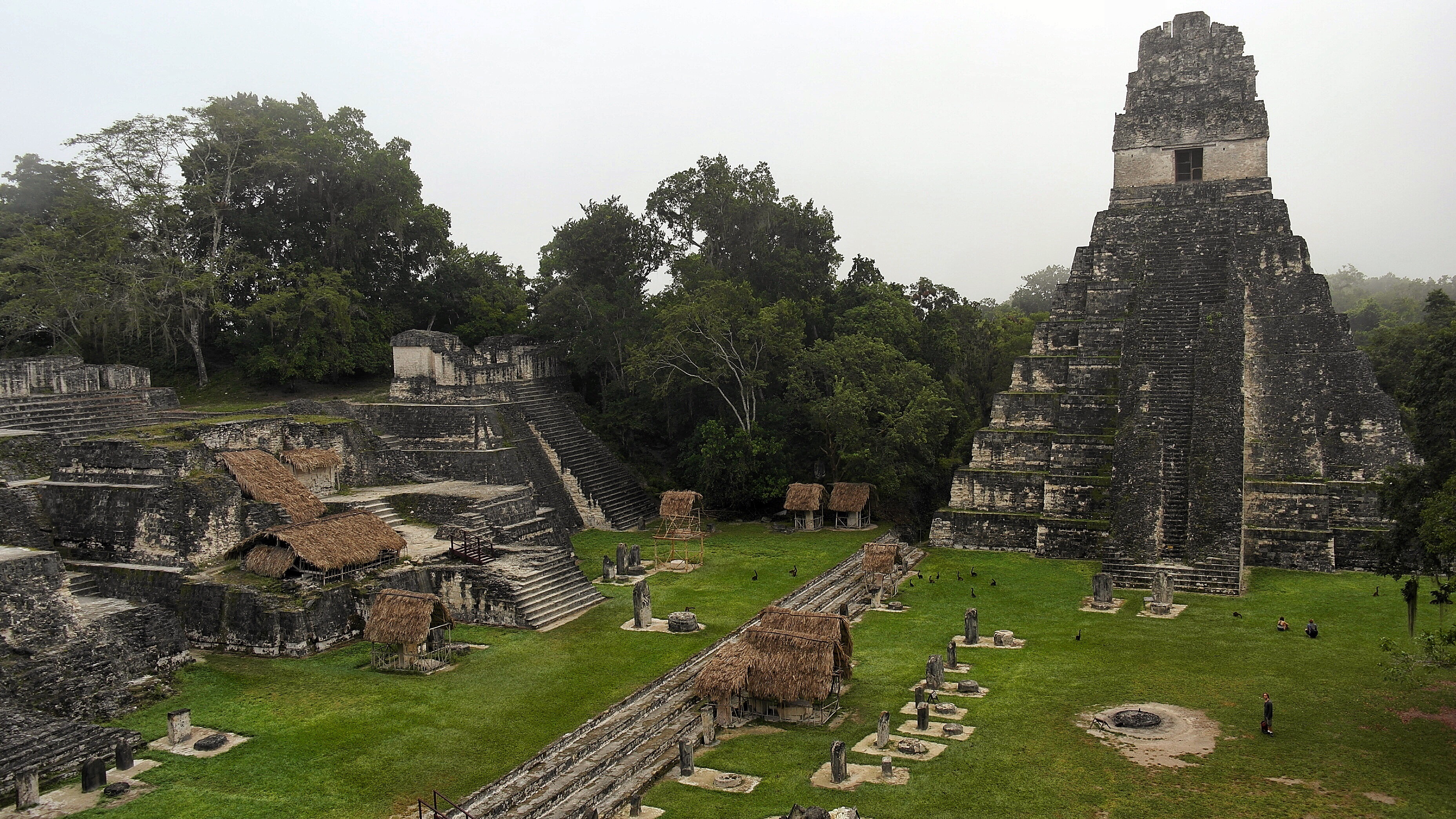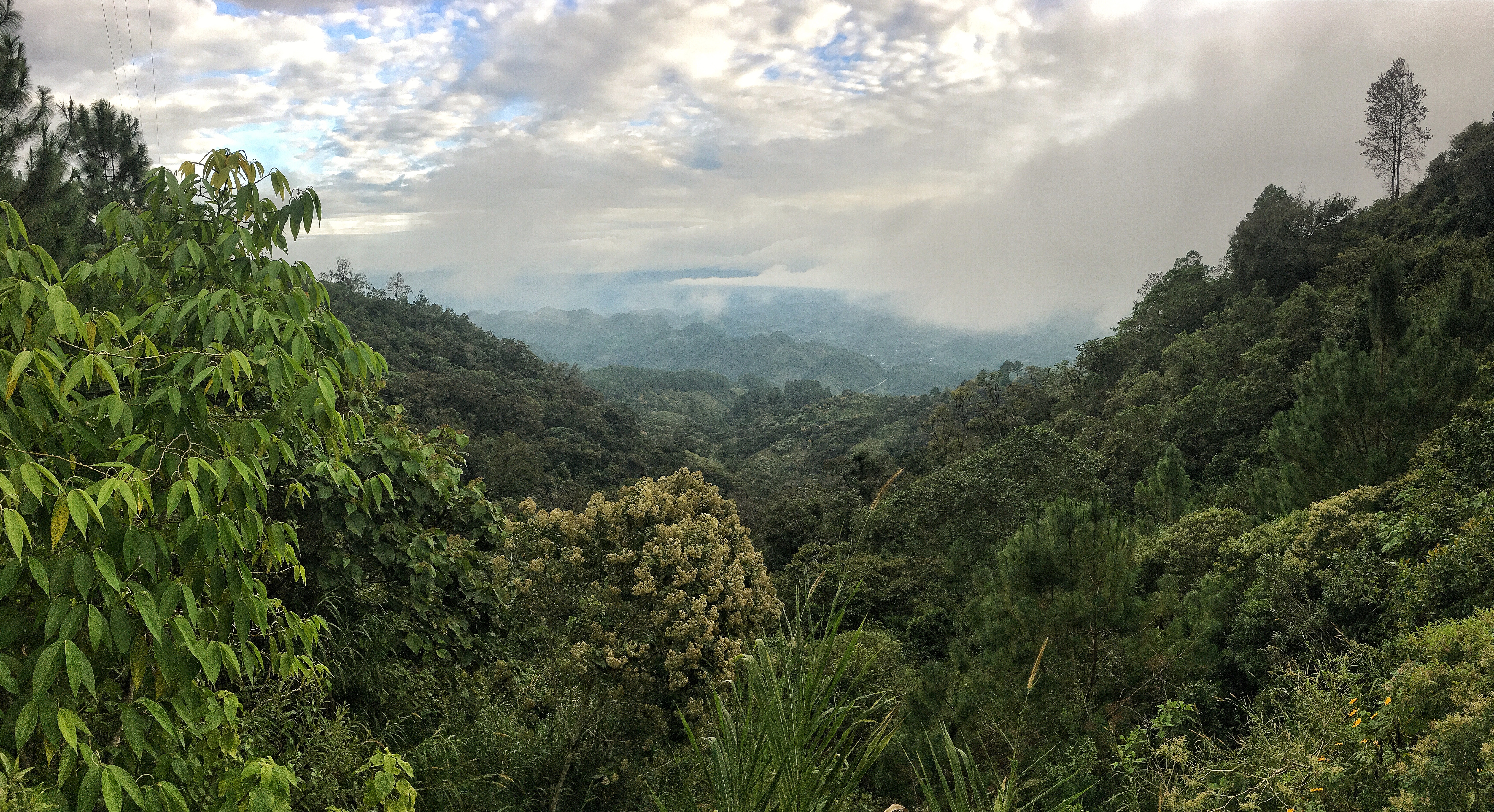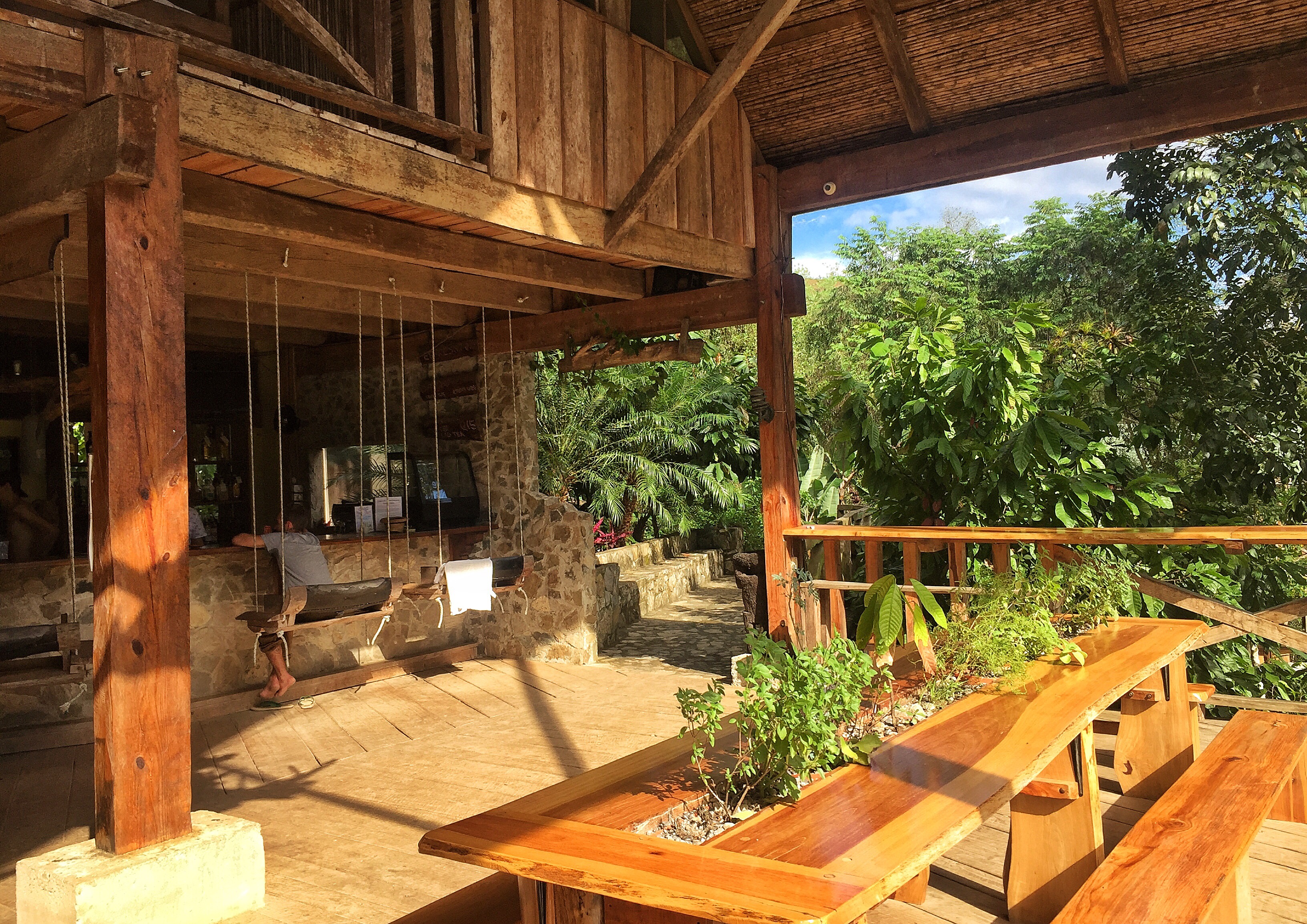Central America trip
December 2016
week 3 of 4
GUATEMALA | MEXICO
The Highlands | Chiapas
by Xavier and Simon
note: for practical details on transport, fares, travel times, etc check out Simon’s HOW WE GOT THERE section further down.

photo: on the long road to Antigua, still smiling at this point…
Antigua Guatemala
After Semuc Champey, our next stop was Antigua Guatemala. We had planned to leave from Lanquín at 6am, which had seemed a good idea at the time, but it meant being picked up from the hostel at 5am so we could make the shuttle. A pickup truck turned up outside the hostel a few minutes after 5am, Latin music blaring over the stereo. As we bumped along the awful road, thankfully inside the truck this time, we saw many locals heading out early to work; some hailed a lift, as this is the only form of public transport in this remote area. Once at Lanquín, we paid the driver 25 quetzales for the journey, swapped vehicles, and braced ourselves for a tiring eight hour drive – nearly a very memorable journey, as Xavier found himself engaged in a battle of wills with a sudden stomach bug about two hours away from our destination, inside a packed minibus and with no toilet in sight… Fortunately for all, Xavier’s will prevailed as we finally arrived in Antigua, a small city that was the capital of the Spanish colonies in Central America until 1773, when it was seriously damaged by an earthquake and the Spanish Crown moved the capital to what is now Guatemala City.
Our stay in Antigua was actually very pleasant. We had booked three nights at Chez Daniel, a nice and comfortable B&B just outside the touristy centre, and spent a few days exploring the city, with its cobbled streets and quaint old buildings, while admiring the view of the surrounding volcanoes that tower over it all: Volcán de Agua (Hunahpú, in Mayan), Acatenango, and Volcán de Fuego (which gives off a cute puff of ash and smoke every few minutes). It reminded us of the city of Arequipa, in Perú, which we visited just under two years ago.
Craving a cultural fix, we set out to visit some of the museums in Antigua, for which we chose to do the Paseo de los Museos (Museums Walk), the entrance of which is through Casa Santo Domingo, one of the poshest hotels in Antigua. Inside, historical buildings and courtyards are the location of various museums, mostly small but well worth a look (entry was ticketed except for hotel guests).
There isn’t much else to do in Antigua itself. The rest of our time there was mostly spent out and about the cafés, bars and restaurants. Just to name a few, and at risk of sounding like a guide book, here are some of the places we liked: the Rainbow Café (excellent breakfast), Cactus (a tiny, very popular place that serves cheap but pretty decent Mexican food and has live music in the evening), Travel Menu (very chilled and run by an expat, it has a definitive western vibes), McDonald’s (kid you not – it’s huge and inside a historical building, which has an amazing courtyard), Pumping Drinks (bubble tea!), The Snug (a fun, super small “Irish” pub which we liked a lot – the other Irish-flavoured bar, Reilly’s, is much larger and better kitted out, but was pretty dead the only night we walked in, and didn’t linger). On our last night we went to Fridas, a cool Mexican restaurant, after reading about it in a copy of Historias Culinarias de la Antigua Guatemala (Culinary Stories of Antigua Guatemala) that was lying around our B&B – a great book for foodies but sadly only on sale at selected bookstores in Antigua.
Of course this was also the run up to Christmas and the locals were stepping up the religious celebrations, and stepping out into the streets for rather lovely evening processions.
And that is very much all of our time in Antigua. There are some outdoors activities on offer in the surrounding area, one of which is the almost compulsory climb to one of the many active volcanoes – which Simon decided to do one day. Here is his account of his climb to Pacaya:
As a rare concession to Guatemalan health and safety you cannot quite climb all the way to the crater. The tour started with another minibus journey, which got held up in a small town which had decided to hold a festival (complete with Disney-esque costumes, dancing and loud music) in the main road, blocking all traffic. By the time we got through this, it was getting late, and some people in the bus wanted to turn back; an American man complained at length about how the company must have known, this wouldn’t happen in his country, and he wanted his money back (fat chance – this is Latin America after all). Everyone else did their best to ignore the man, and we pushed on.
The climb was quite hard work, as the path was steep and in places deep in volcanic ash (which is slippery). Local children walked alongside offering horses, for a modest fee, to carry people up; a few opted for this but most of us persevered on foot. Once at the top, we were rewarded with spectacular views over the volcano, as the sun set in the background. We then part-walked, part-slid, down to a lava field, where holes had been dug down to where the lava is still hot, for us to toast marshmallows.
The obvious problem with watching the sun set was that we would need to get down the steep and slippery path in the dark, which didn’t appear to bother our guide but, as it got later and later, was clearly beginning to worry several people in the group. I asked the guide if he had a torch; he assured me he did, but if that was true he never felt the need to use it. Fortunately, I and others had enough power left on our mobile phones, and used these to light our way down.
Lake Atitlán
The deepest lake in Central America and one of the largest, Lake Atitlán fills up a vast volcanic caldera, and its shores are peppered with small villages inhabited mainly by people of Maya culture. One of these villages is San Pedro La Laguna (laguna being Spanish for lake), where we travelled to from Antigua.
Of the numerous villages around the lake, only a handful seem to be deemed safe enough for visitors, San Pedro among them. It attracts an eclectic crowd of visitors, including hippies and “Woodstock” hipsters, who form an incongruous mix with the local population. We arrived in the centre of San Pedro after a mere four hour drive, and once we retrieved our backpacks we walked to our B&B, Luna Azul, on the outskirts of the village. It was a peculiar place, somewhat reminiscing of Albert and David Maysles’ Grey Gardens, not least because of its wonderfully eccentric manager, Erin, who looked after us amazingly well. We loved staying there, especially since we seemed to be the only guests for the entire time we were there, so we really had the place to ourselves – resident spiders and scorpions notwithstanding.
San Pedro is a busy village during the day; it has steep and narrow streets and amazing views of the lake and the towering sides of this ancient caldera. On Erin’s recommendation we had a surprisingly good and very cheap steak dinner on our first night at the Wild Rover, an “Irish” themed pub formerly known as the Buddha, which is more like a backpackers bar with live music. It turned out to be the place to be in San Pedro. We didn’t find a fuller place on any of the evenings we were there. Great fun.
video: Annie Lennox had a very sore throat.
The next day we set out on a tour of the area, first hiking to nearby San Juan where we were hoping to get a boat that would take us to one of the other villages. In hindsight, we should have taken a local tuk tuk – the main means of transportation by land – as the hike wasn’t particularly nice. After walking around San Juan for a bit and stopping for coffee, we headed to the pier; however, the day was very windy and there were no boats from this side of the lake, so we got on a tuk tuk back to San Pedro and from its main pier it was easy to get on a boat across the lake to the picturesque village of San Marcos, where we finished our little tour with a nice lunch in a vegetarian (!) restaurant called Il Giardino before getting the boat back to San Pedro. That night, and also on Erin’s recommendation, we ate quite possibly one of the best Italian meals we have ever had, at a very unassuming restaurant near the main pier called Pequeños Pecados (Small Sins), run by a family from northern Italy who clearly love making delicious food. One of the dishes we ordered wasn’t available so they improvised a plate of exquisite balanzoni with gorgonzola that wasn’t even on the menu. A really nice dinner, which we repeated on our last night in San Pedro. It’s amazing how you can sometimes get such great food in the most unpromising looking places.
Looking for more things to do, and rather unexpectedly, Simon agreed to go horse-riding on another of our days there. It is, unfortunately, not safe for foreigners to venture unaccompanied along the edge of the lake, so we went to Maya Travel and hired a guide and two not terribly healthy looking horses to ride a few kilometres along the lake and around the base of Volcán San Pedro for more spectacular views, a bit of knowledge of the area, and an insightful chat with our guide about the local economy and politics. Simon had not ridden a horse before and managed not to fall off it so this mini adventure was also ticking another activity off the list.
Walking around the higher parts of San Pedro, away from the shore, we got to see some interesting things like the fantastic day market, which is an assault to the senses, and the lighting on the facade of the church of San Pedro La Laguna, which looked amazing at night (a little caution is advisable if walking around the higher parts of San Pedro at night, but we didn’t have any problems).
On our last night, the main ATM by the pier was out of order and what could have been a tricky situation (we needed enough cash to pay for dinner and the 5am boat out of San Pedro) was saved by a young and entrepreneurial tuk tuk driver, who took a chance on us and drove us to the other ATM in San Pedro right at the top of the village without the assurance of payment if this machine was also out of order, which fortunately it wasn’t so he got a nice tip on top of the fare.
We absolutely loved Guatemala, not so much its roads, but it definitely surpassed all of our expectations. We would have happily stayed longer had it not been because Christmas was upon us and we had decided to spend it back over the border in Mexico.
San Cristóbal de las Casas
Getting up at 5am to catch the boat out of San Pedro wasn’t precisely appealing. We grabbed our backpacks and walked to the pier under a cold starry night, the village eerily deserted. But the early morning ride across the water, just as the sun was rising over the surrounding volcanoes, was breathtakingly beautiful and a fitting last impression of Lake Atitlán.
Once in Panajachel we got on the shuttle to Mexico just after 7am, and another lengthy journey and a particularly chaotic border crossing later we reached San Cristóbal. One of the travel websites that Simon used to plan the trip, and which he would generally recommend: travelindependent.info, dismisses San Cristóbal as being “to backpackers what Cancún is to package tourists“, but in fact it felt the reverse. Possibly because Mexico is rich enough to have its own domestic tourism industry, and it was holiday season, it felt like we were stepping off the Gringo Trail and, from this point on, we no longer saw familiar faces at every turn. At any rate, we welcomed the nicely surfaced roads this side of the border.
In San Cristóbal we stayed at Casa Selah, a beautiful and homely hotel in the centre, which worked out really well in the end. Like in Antigua (but with better paving), we spent the days walking around the city, popping in and out its many churches, historical buildings, and public squares, as well as the cafés, bars and restaurants (won’t reel off another list, worry not). We also hiked to the top of the two hills (cerros) on either side of the centre, the Cerro de San Cristóbal and Cerro de Guadalupe, both of which have big churches on their summits as well as great views over the city. Cerro de Guadalupe is by far the most interesting of the two, the church at its top is definitely worth the steep climb, and the surrounding neighbourhood feels much safer and nicer than by Cerro de San Cristóbal, especially at night.
Simon also took himself on a tour of the Sumidero Canyon, about an hour’s drive from San Cristóbal. It then took him about two hours by boat to see this spectacular canyon, in some ways reminiscent of Milford Sound in New Zealand, but with better weather; the boat also stopped for the group to get a good look at the canyon’s wildlife, which includes crocodiles!.
It eventually got to the day before Christmas Eve and we still hadn’t made any plans for the two days ahead. We hastily did some research and, after some difficulties with the hotel’s staff, Xavier managed to sort things out at this very short notice. For our dinner on Christmas Eve we secured a table at El Secreto, apparently one of the best restaurants in the city according to the reviews, which was offering a special festive menu at what would have been a fairly hefty price even by London standards. Mexican food, despite our different levels of enthusiasm, had generally been very good during our trip so our expectations were high. They certainly weren’t met at El Secreto. This was by and large the worst meal we had in Mexico, as well as being multiples of the price of any other. Five courses, which varied from dull to borderline inedible, were served in quick and awkward succession, and we left within 90 minutes, worse off and very disappointed. Fortunately, Christmas Day was much better. Having walked up to the Cathedral for Christmas Day Mass, we then headed off to lunch with some trepidation but our faith in Mexican cuisine was fully and duly restored at LUM, the restaurant at super cool b¨o hotel, where we had an excellent meal, and much cheaper!
After such emotional roller coaster it was again time to think about our travel schedule. We had planned to stop in Palenque next, to look at even more ruins. This should have been a five hour drive; unfortunately, southeast Mexico is still a bit unstable partly as a legacy from the Zapatista rebellion in the 1990s when San Cristóbal was briefly taken over by the rebels (the Mexican army regained control within a few days). Some people in the region have now taken to blockading roads and sometimes attacking buses and as a result we found out that of the two bus companies one wasn’t operating at all and the other was taking a less direct route to avoid problems, over a whopping nine hours via Tuxtla Gutiérrez, Cárdenas and Ciudad del Carmen – look it up.
So, on Boxing Day, when many people back at home were slowly starting to bring themselves back from the brink of alcoholism and diabetes, we embarked on another long bus journey. Yay.
.
👉 HOW WE GOT THERE
The practical details
by Simon
Lanquín to Antigua: depending on the company this may leave at either 6am or 8am with hostel pickup up to an hour before. Buy in advance, if possible before arriving at your hostel as this seemed to be cheaper. We paid 100 quetzales compared to 175 offered at our hostel in Semuc; however, we also had to pay 25 for the journey from the hostel back to Lanquín. You can book this at a travel agent in Flores; we bought from an agent on board the shuttle from Flores. Journey time: 8 hours including two stops.
Antigua to San Pedro La Laguna: there are several daily tourist shuttles, taking about four hours including stops. Buy from a travel agency or hostel in Antigua. The best price we could find was 80 quetzales.
San Pedro to San Cristobal de las Casas: there is a daily shuttle from Panajachel to San Cristóbal, leaving at 7am and arriving around 4pm. From anywhere else on the lake it’s necessary to get an early boat to Panajachel. From San Pedro we took what is theoretically a 6am boat, but which left 10 minutes early (fortunately we were warned in advance). All agents in San Pedro seemed to be selling the shuttle for 160 quetzales, plus we had to pay 25 for the boat. There is a switch of minibuses at the border; the vehicle, road and driving on the Mexican side were all notably better than in Guatemala.
note: all details correct at time of publishing.
previous | next about this blog





